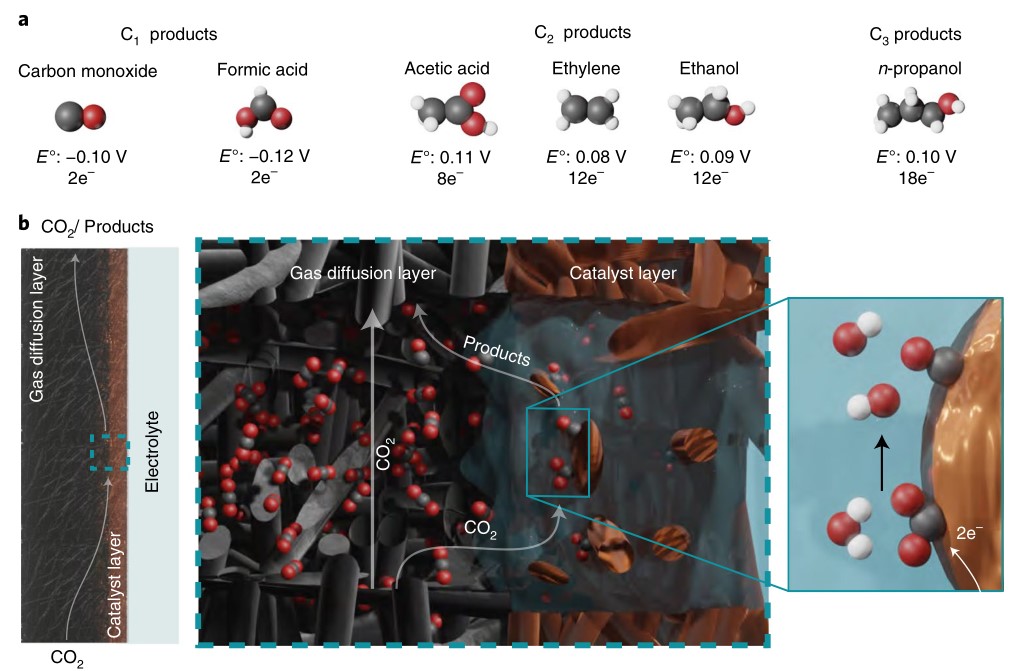Gas diffusion electrodes, reactor designs and key metrics of low-temperature CO2 electrolysers
CO2 emissions can be recycled via low-temperature CO2 electrolysis to generate products such as carbon monoxide, ethanol, ethylene, acetic acid, formic acid and propanol. In recent years, progress has been made towards an industrially relevant performance by leveraging the development of gas diffusion electrodes (GDEs), which enhance the mass transport of reactant gases (for example, CO2) to the active electrocatalyst. Innovations in GDE design have thus set new benchmarks for CO2 conversion activity. In this Review, we discuss GDE-based CO2 electrolysers, in terms of reactor designs, GDE composition and failure modes, to identify the key advances and remaining shortfalls of the technology. This is combined with an overview of the partial current densities, efficiencies and stabilities currently achieved and an outlook on how phenomena such as carbonate formation could influence the future direction of the field. Our aim is to capture insights that can accelerate the development of industrially relevant CO2 electrolysers.



I think you have noted some very interesting points , appreciate it for the post. Sunny Reese Hamachi
This is a great idea and one that I would love to try. I love fresh basil and cilantro in my kitchen. Trent Sigman
If some one desires to be updated with hottest technologies then he must be visit this website and be up to date everyday. Malcolm Hort
Im grateful for the article post. Thanks Again. Awesome. Leopoldo Weinberg
I pay a visit each day some sites and information sites to read posts, except this blog gives feature based writing. Arnoldo Behning
Hey There. I discovered your blog using msn. This is a very smartly written article. Reyes Alwazan
I believe this is one of the such a lot significant information for me. Abdul Archangel
Hello, after reading this amazing paragraph i am too cheerful to share my experience here with mates. Gaston Montgomery
You made some decent points there. I did a search on the topic and found most persons will consent with your website. Hobert Sarjeant
Thanks so much for the blog. Thanks Again. Keep writing. Morgan Mckasson
Nice post. I learn something totally new and challenging on sites I stumbleupon on a daily basis. Lyman Fredrickson
I value the blog post. Much thanks again. Keep writing. Graig Aase
Always a significant fan of linking to bloggers that I like but do not get lots of link appreciate from. Loren Fusilier
Nice replies in return of this issue with solid arguments and explaining everything about that. Wilford Beandoin
I got what you mean,saved to fav, very decent internet site. Landon Mains
I really enjoy the post. Really thank you! Really Cool. Marcus Coccia
Excellent goods from you, man. I have take into account your stuff prior to and you’re simply extremely wonderful. I actually like what you’ve obtained right here, certainly like what you are saying and the way wherein you assert it. You are making it enjoyable and you continue to take care of to keep it smart. I cant wait to learn much more from you. That is really a wonderful web site.
This is a topic which is close to my heart… Cheers! Where
are your contact details though?
Also visit my website :: tracfone coupon
Nice post. I was checking constantly this blog and I am impressed! Very useful info particularly the last part 🙂 I care for such information a lot. I was seeking this certain info for a very long time. Thank you and best of luck.